前言
在开发过程中,肯定避免不了读取文件操作,比如读取配置文件、上传和下载文件、Web中html、js、css、图片等静态资源的访问;在配置文件读取章节中有说到,针对不同配置源数据读取由对应的IConfigurationProvider进行读取,其实读取文件也是一样,针对于不同类型(物理文件、嵌入文件、云端文件等)文件,就由对应的IFileProvider的实现进行读取,下面详细说说;
正文
由于通过IFileProvider将目录文件进行抽象化,统一规范读取操作,使得读取不同地方的文件就显得更加方便,如物理文件、嵌入文件,只要有对应的实现即可;而框架针对物理文件和嵌入文件已经进行了具体实现,如下:
- PhysicalFileProvider:物理文件提供程序,用来读取物理文件,就是平时使用的文件,不管是扩展名是什么;
- EmbeddedFileProvider:嵌入文件提供程序,用来读取嵌入文件,就是程序编译时嵌入到程序集内部的文件,就像资源文件一样;
- CompositeFileProvider:组合提供程序,同时可以读取物理文件和嵌入文件,就是可以指定多种数据源,这样的好处就是像操作同一个数据源一样;后续也可以与自定义的提供程序进行组合;
为了避免直接扒代码懵圈,先来个控制台例子,体验一下以上xxxProvider的使用:
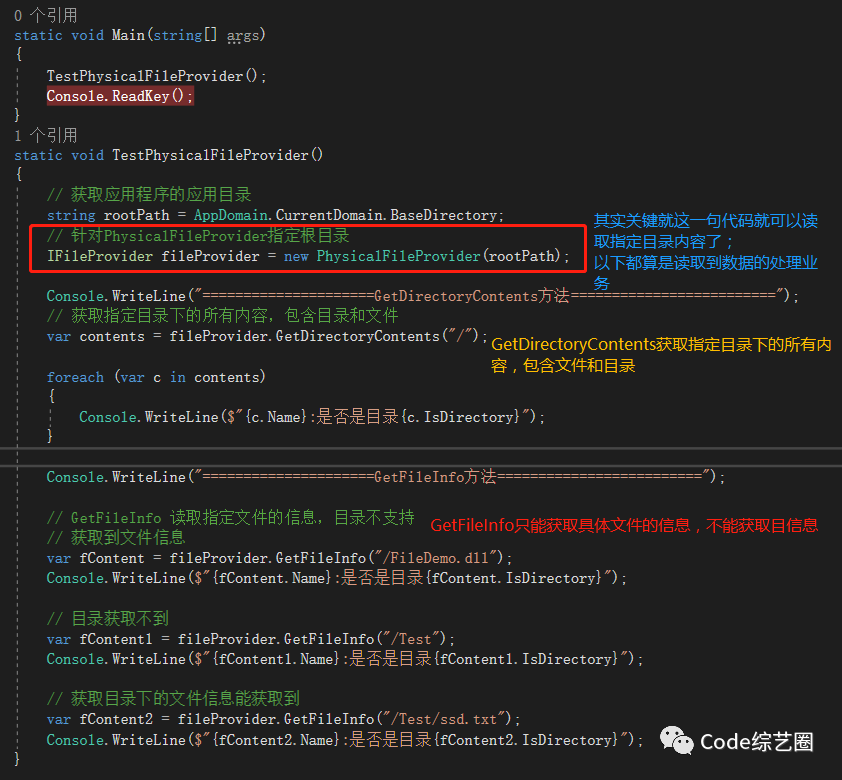
运行结果:
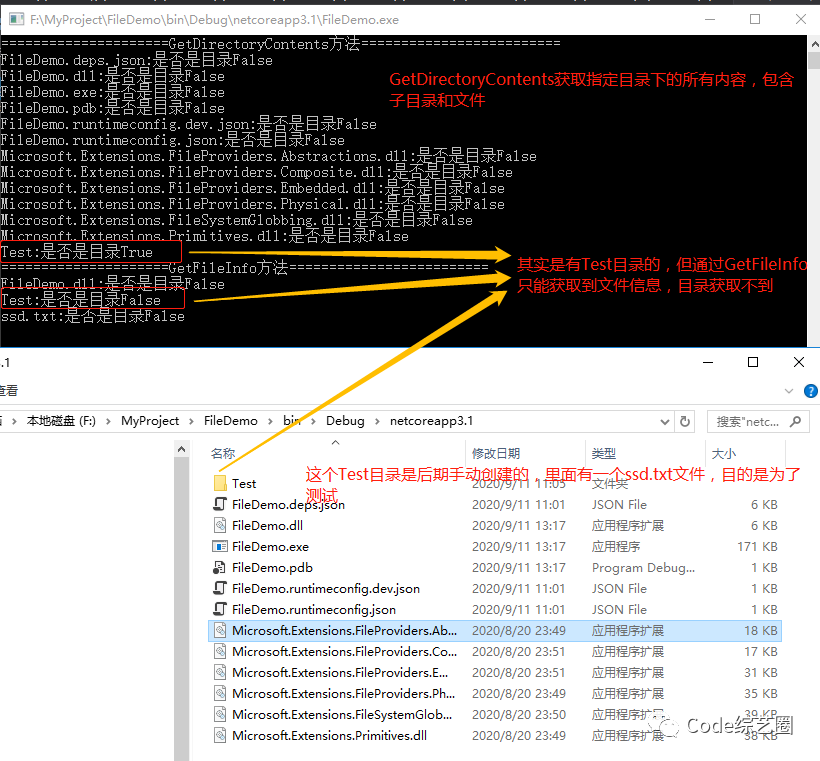
读取物理文件是不是很简单,其实就是创建了一个PhysicalFileProvider对象时指定了一个路径,然后就能很方便的获取到对应目录下的信息;
嵌入文件也是如此,只需指定对应程序集即可(因为嵌入文件已经编译到程序集中),如下优化代码:
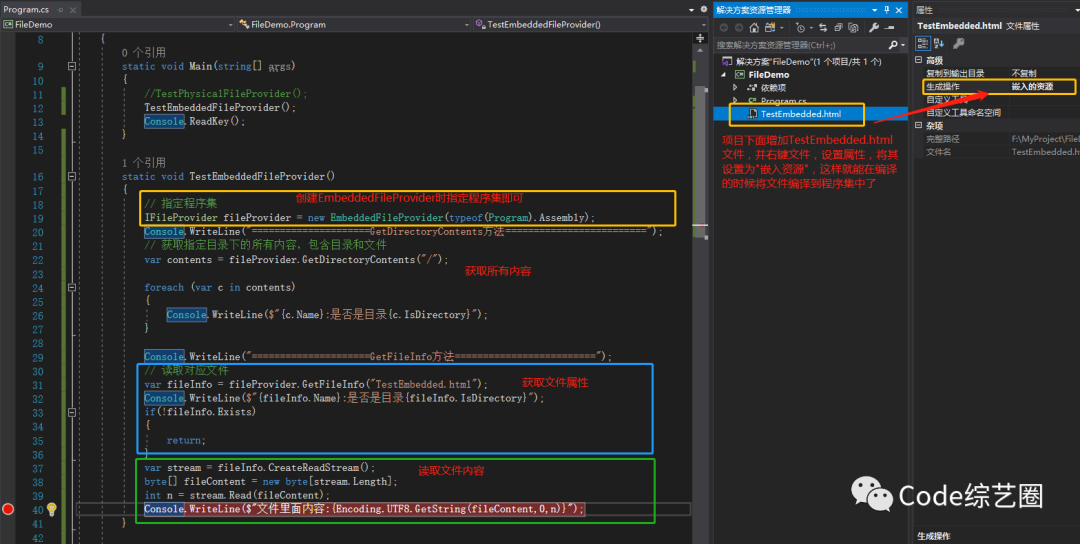
运行结果如下:
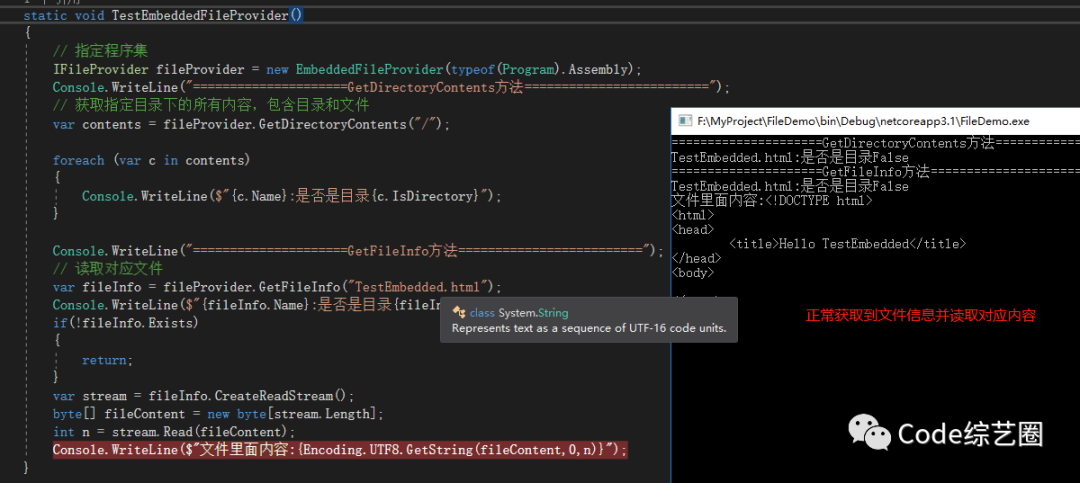
同样也是使用很简单,只是在创建EmbeddedFileProvider对象时指定一下对应的程序集即可,后续便可以用统一的方式进行文件和目录操作;
组合提供程序的目的就是将不同提供程序整合,就像使用同一个源一样,如下:
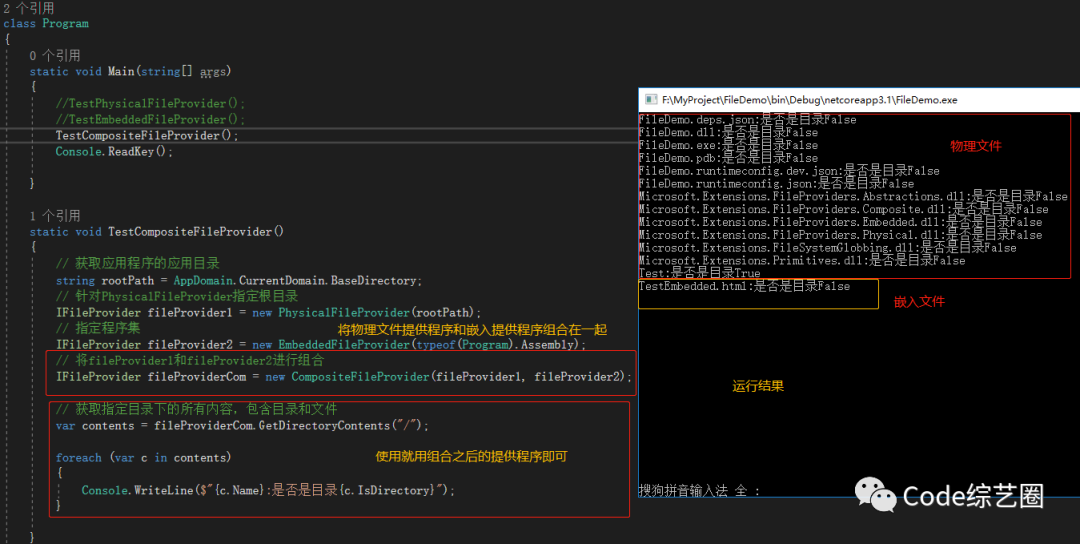
当然,按老套路走,不能用用就行了,继续扒扒代码,先看看IFileProvider:
namespace Microsoft.Extensions.FileProviders
{
// IFileProvider定义的三个方法其实就是其对应的三大功能
public interface IFileProvider
{
// 获取指定文件的信息,之后可以文件进行读取操作
IFileInfo GetFileInfo(string subpath);
// 获取指定目录下所有内容
IDirectoryContents GetDirectoryContents(string subpath);
// 用于监听文件改变
IChangeToken Watch(string filter);
}
}
再来看看返回的IFileInfo和IDirectoryContents :
namespace Microsoft.Extensions.FileProviders
{
public interface IFileInfo
{
// 标识是否存在
bool Exists
{
get;
}
// 文件大小,如果不存在或是目录,这个值就是-1
long Length
{
get;
}
// 对应的物理路径,其实就是文件的实际路径
string PhysicalPath
{
get;
}
// 文件名字
string Name
{
get;
}
// 文件最后的修改时间
DateTimeOffset LastModified
{
get;
}
// 标识是否是目录
bool IsDirectory
{
get;
}
// 返回的留可以进行文件读取
Stream CreateReadStream();
}
// 其他信息继承了IFileInfo信息
public interface IDirectoryContents : IEnumerable<IFileInfo>, IEnumerable
{
// 标识指定目录是否存在
bool Exists
{
get;
}
}
}
IChangeToken 之前在配置文件监听的时候有提到过,是用来监听到文件改变时进行发送通知的,这里就不深入了,感兴趣的小伙伴可以研究研究;
PhysicalFileProvider和EmbeddedFileProvider两个挑PhysicalFileProvider这个看看,后者小伙伴私下去扒吧:
namespace Microsoft.Extensions.FileProviders
{
// 这里只挑了几个关键方法说明,其他属性和方法删除
public class PhysicalFileProvider : IFileProvider, IDisposable
{
// 判断路径是否在指定的根路径下
private bool IsUnderneathRoot(string fullPath)
{
return fullPath.StartsWith(Root, StringComparison.OrdinalIgnoreCase);
}
// 获取指定路径文件的FileInfo信息
public IFileInfo GetFileInfo(string subpath)
{
// 判断路径是否处匹配
if (string.IsNullOrEmpty(subpath) || PathUtils.HasInvalidPathChars(subpath))
{
return new NotFoundFileInfo(subpath);
}
// 判断指定的路径是否是在根目录下
subpath = subpath.TrimStart(_pathSeparators);
if (Path.IsPathRooted(subpath))
{
return new NotFoundFileInfo(subpath);
}
// 获取全路径,因为一般在外面操作是根据相对路径进行操作
string fullPath = GetFullPath(subpath);
if (fullPath == null)
{
return new NotFoundFileInfo(subpath);
}
// 构建了一个文件信息,包含文件的的操作和属性;
FileInfo fileInfo = new FileInfo(fullPath);
if (FileSystemInfoHelper.IsExcluded(fileInfo, _filters))
{
return new NotFoundFileInfo(subpath);
}
// 封装成PhysicalFileInfo对象
return new PhysicalFileInfo(fileInfo);
}
// 获取指定目录下的所有内容
public IDirectoryContents GetDirectoryContents(string subpath)
{
try
{
// 路径校验和上面一样
if (subpath == null || PathUtils.HasInvalidPathChars(subpath))
{
return NotFoundDirectoryContents.Singleton;
}
subpath = subpath.TrimStart(_pathSeparators);
if (Path.IsPathRooted(subpath))
{
return NotFoundDirectoryContents.Singleton;
}
string fullPath = GetFullPath(subpath);
if (fullPath == null || !Directory.Exists(fullPath))
{
return NotFoundDirectoryContents.Singleton;
}
// 封装为PhysicalDirectoryContents对象
return new PhysicalDirectoryContents(fullPath, _filters);
}
catch (DirectoryNotFoundException)
{
}
catch (IOException)
{
}
return NotFoundDirectoryContents.Singleton;
}
// 用监听文件改变的,通过文件匹配模式来指定需要监控的文件
public IChangeToken Watch(string filter)
{
if (filter == null || PathUtils.HasInvalidFilterChars(filter))
{
return NullChangeToken.Singleton;
}
filter = filter.TrimStart(_pathSeparators);
return FileWatcher.CreateFileChangeToken(filter);
}
}
}
以上GetDirectoryContents和GetFileInfo分别返回的PhysicalDirectoryContents和PhysicalFileInfo才是关键,进去瞅瞅:
public class PhysicalDirectoryContents : IDirectoryContents, IEnumerable<IFileInfo>, IEnumerable
{
// 用于存放指定目录下的全部内容的
private IEnumerable<IFileInfo> _entries;
// 判断指定目录是否存在
public bool Exists => Directory.Exists(_directory);
// 读取目录内容的关键方法
private void EnsureInitialized()
{
try
{
// 根据指定的目录,获取目录下的所有内容,将其保存在集合中
_entries = new DirectoryInfo(_directory).EnumerateFileSystemInfos().Where((Func<FileSystemInfo, bool>)((FileSystemInfo info) => !FileSystemInfoHelper.IsExcluded(info, _filters))).Select((Func<FileSystemInfo, IFileInfo>)delegate (FileSystemInfo info)
{
// 将取到的内容封装为PhysicalFileInfo对象
FileInfo fileInfo = info as FileInfo;
if (fileInfo != null)
{
return new PhysicalFileInfo(fileInfo);
}
// 将取到的内容封装为PhysicalFileInfo对象
DirectoryInfo directoryInfo = info as DirectoryInfo;
if (directoryInfo != null)
{
return new PhysicalDirectoryInfo(directoryInfo);
}
throw new InvalidOperationException("Unexpected type of FileSystemInfo");
});
}
catch (Exception ex) when (ex is DirectoryNotFoundException || ex is IOException)
{
_entries = Enumerable.Empty<IFileInfo>();
}
}
}
PhysicalFileInfo
// 其实里面就是封装了IO文件操作的相关属性和操作
public class PhysicalFileInfo : IFileInfo
{
// 文件信息,就是平时咱们直接读取到文件的那些信息
private readonly FileInfo _info;
// 是否存在
public bool Exists => _info.Exists;
// 文件大小
public long Length => _info.Length;
// 文件的全路径
public string PhysicalPath => _info.FullName;
// 文件名称
public string Name => _info.Name;
// 文件的最后修改时间
public DateTimeOffset LastModified => _info.LastWriteTimeUtc;
// 默认就是false,所以这里只能对文件有效
public bool IsDirectory => false;
public PhysicalFileInfo(FileInfo info)
{
_info = info;
}
// 获取文件流,并设置了只读权限
public Stream CreateReadStream()
{
int bufferSize = 1;
// 这里就熟悉了,平时直接读取文件就是这样的
return new FileStream(PhysicalPath, FileMode.Open, FileAccess.Read, FileShare.ReadWrite, bufferSize, FileOptions.SequentialScan | FileOptions.Asynchronous);
}
}
好了,到这其实差不多就明白了,至少知道为什么IFileInfo只能获取到文件件信息,目录信息获取不到;至少在写文件的时候不再懵逼的在想:为什么不能写文件了,如果直接用返回的流进行文件写操作,就会报以下错:

总结
框架只是实现了本地读取的两个IFileProvider,如果针对于云端文件、FTP文件等有统一的读取需求,则就需要自己实现了;所以源码是不错的参考,封装之后,结合组合提供程序,后续使用就能像使用本地文件一样简便;
加上这篇,总共十五篇,把.NetCore中比较关键的核心都过了一遍,其中包含了启动流程、依赖注入、配置、选项、日志、中间件、文件,在每个章节中都会针对对应的核心类型进行源代码分析,虽然只是浅读,但也能明白其中缘由;后续的文章将会偏应用,比如静态文件目录配置、API的最佳实现、JWT使用、IdentityServer4的集成等等一堆组件的应用;
同时,后续将同步开启另一个专题:跟我一起学Redis,欢迎一起来学习;
------------------------------------------------
CSDN:Code综艺圈
知乎:Code综艺圈
掘金:Code综艺圈
博客园:Code综艺圈
bilibili:Code综艺圈
------------------------------------------------
一个被程序搞丑的帅小伙,关注"Code综艺圈",识别关注跟我一起学~~~

撸文不易,莫要白瞟,三连走起~~~~